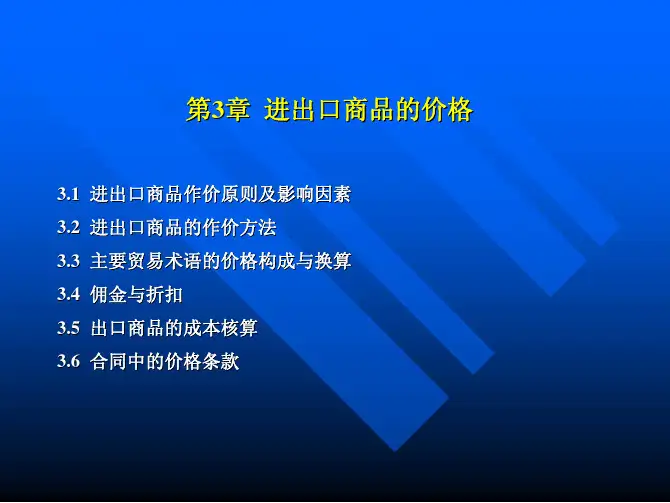《国际贸易实务与操作》Chapter 3
- 格式:ppt
- 大小:229.00 KB
- 文档页数:26
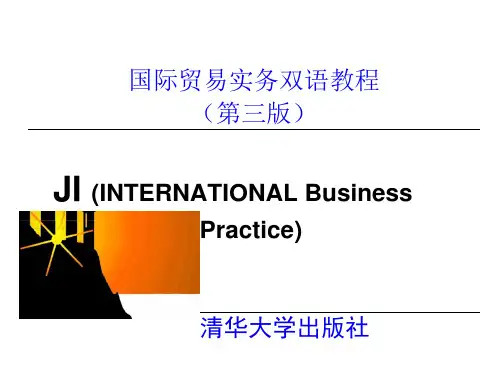
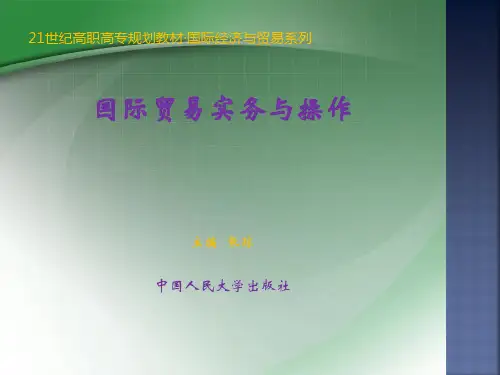
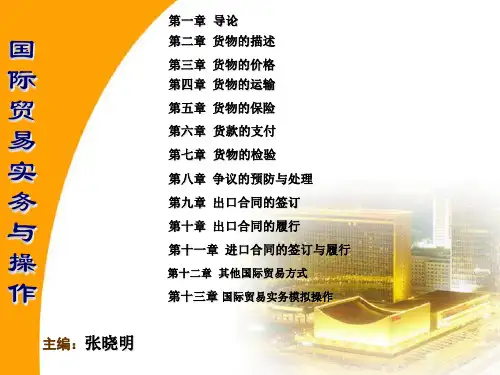

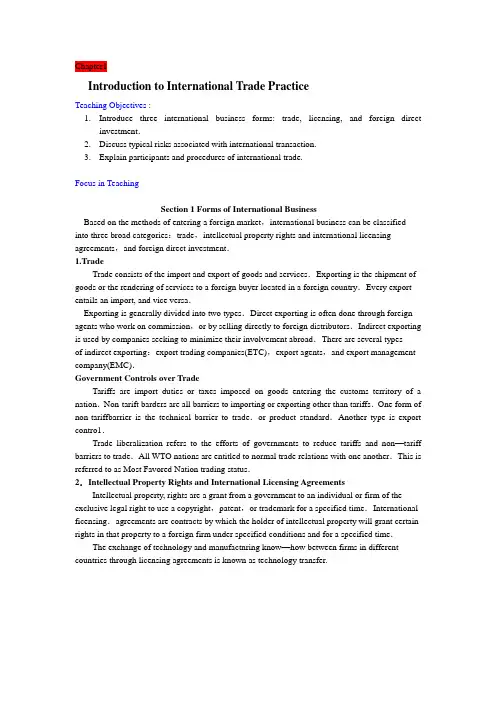
Chapter1Introduction to International Trade PracticeTeaching Objectives :1.Introduce three international business forms: trade, licensing, and foreign directinvestment.2.Discuss typical risks associated with international transaction.3.Explain participants and procedures of international trade.Focus in TeachingSection 1 Forms of International BusinessBased on the methods of entering a foreign market,international business can be classified into three broad categories:trade,intellectual property rights and international licensing agreements,and foreign direct investment.1.TradeTrade consists of the import and export of goods and services.Exporting is the shipment of goods or the rendering of services to a foreign buyer located in a foreign country.Every export entails an import, and vice versa.Exporting is generally divided into two types.Direct exporting is often done through foreign agents who work on commission,or by selling directly to foreign distributors.Indirect exporting is used by companies seeking to minimize their involvement abroad.There are several typesof indirect exporting:export trading companies(ETC),export agents,and export management company(EMC).Government Controls over TradeTariffs are import duties or taxes imposed on goods entering the customs territory of a nation.Non-tarift barders are all barriers to importing or exporting other than tariffs.One form of non-tariffbarrier is the technical barrier to trade.or product standard.Another type is export contro1.Trade liberalization refers to the efforts of governments to reduce tariffs and non—tariff barriers to trade.All WTO nations are entitled to normal trade relations with one another.This is referred to as Most Favored Nation trading status.2.Intellectual Property Rights and International Licensing AgreementsIntellectual property, rights are a grant from a government to an individual or firm of the exclusive legal right to use a copyright,patent,or trademark for a specified time.International ficensing.agreements are contracts by which the holder of intellectual property will grant certain rights in that property to a foreign firm under specified conditions and for a specified time.The exchange of technology and manufactnring know—how between firms in different countries through licensing agreements is known as technology transfer.Franchisind is a popular form of licensing.The franchisee is allowed to use a trade name or trademark in offering goods or services to the public in return for a royalty based on a percentage ofsales or other fee structure.Case 1-1(Dayan v.McDonald's Corp.)Dayan in Paris had an exclusive franchise agreement with McDonald’S in 1971.The agreement required that Dayan meet all quailty,service and cleanliness(QSC)standards set by McDonald‟S Due to quality and cleanliness violations for a long time,McDonald’S te rminated the franchise agreement with Dayan.Dayan couldn’t operate the restaurant with McDonald'S trademarks or name.3.Foreign Direct InvestmentForeign investment or foreign direct investment refers to the ownership and active control of ongoing business concerns,including investment in manufacturing,mining,farming,assembly operations,and other facilities of production.A distinction iS made between the home and host countries ofthe firms involved.The home country refers to that country under whose laws the investing corporation was created or is headquartered.Multinational Corporations are firms with significant foreign direct investment assets.Through direct investment,they can start a new foreign subsidiary company,form a ioint venture with an existing foreign company or acquire an existing foreign company by stock purchase.Multinational corporations are usually not a single legal entity.Of the three Forms of international business.Foreign investment provides the firm with the most involvement,and perhaps the greatest risk abroad.Investment in a foreign plant is often a result of having had successful experiences in exporting or licensing,and of the search for ways to overcome the disadvantages ofthe other entry methods.Section 2 Managing Risks of International Business TransactionsIn general,the level of risk rises from trade to licensing,and to foreign direct investment.The risks will also vary depending on which countries the business parties are located in or which country the transaction is to be performed in.1.PoliticaI RiskPolitical risk is generally defined as the risk to a firm‟s business interests resulting from political instability or political change in a country in which the firm is doing business.Handling political risk requires planning and vigilance.2.Language and Cultural DifferencesEven though English is widely used in business all over the world,the language of a given transaction still depends on the type of business one is doing and on the region of the world.One device to overcome language differences is to have the contract drawn in both the languages of the parties.Case I-2(Gaskin v.StllllllH HandelGmbh)Gaskin(an Ame rican citizen)could not speak o r read German,but he ente red into an employment cont ract written entirely in German with the German firm of Stumm Handel operated in New York.When he siRned the contract,the terms of the cont ract we re explained to him in English, includinR the "foum selection clause"of settling any disputes in the courts of Germany. Late r,the two parties had a disagreement Gaskin b rought this action against the German stumm Handel in the United States.but the cou rt dismissed his action due to his own negligence.3.Currency and Exchange Rate RisksThree separate risks relate to currency and international business transactions:convertibility, repatriation,and currency rate fluctuation.Such risk management refers to hedging currency risk.Case 1-3(Bernma Disuibucors,Inc.v.Bermna SewmgMach.)Bernina Sewing Machine Co.(Importer)had a seven-year contrad to import and supply Bernina sewing machines to Bernina Distributors in the US The importer was required to pay in Swiss francs.With the sharp decline of the dollar against the Swiss franc,the importer's costs doubled and thus halved its rate of return per dollar invested.So the importer wanted to cancel the contract with the distributor.But the cou rt ruled that the impo rte r bear the currency fludLuation risk according,to the contract.4.Legal RiskBecanse of differences in language,culture,and legal systems,the intentions of parties in an international transaction may not be easily discernable from their contract.The parties should express carefully intended rights and obligations in a written contract.5.Special Transaction Risks in Contracts for the Sale of GoodsThe risk that a buyer will default on a sales contract and fail to pay for the goods is known as payment risk,or credit risk.The risk that a buyer will not receive the goods udder a contract is called delivery risk.This textbook will focus on the special risks inherent in international transactions for the sale of goods.Section3 Participants and Procedures of Import-Export Transactions 1.ParticipantsThe core parties:the Seller and the BuyerOther important parties:the International Banks,the Freight Forwarder/Carrier,the Insurance Company,the Customs BrokerParties involved:the Export and Import Authority,the Chamber of Commerce,the Consular Office,the Notary Public,the Governmeut Regulatory Agency,the Attorney2.General Procedures of an Import-Export TransactionStage 1:Preparing for exporting or importing.Stage 2:Making a deal(refer to Chapter 2,Chapter 3 and Chapter 4).Stage 3:Fulfilling the contract(refer to Chapter 5,Chapter 6,Chapter 7,Chapter 8,Chapter 9 and Chapter 10).Stage 4:Settlement ofdisputes frefer to Chapter 1 1 and Chapter 12).Difficult Points in TeachingHedging Currency Risk (Extension)In finance,a hedge, is a position established in one market in an attempt to offset exposure to price fluctuations in some opposite position in another market with the goal of minimizing one‟s exposure to any unwanted risk.There are many specific financial vehicles to accomplish this,including insurance policies,forward contracts,swaps,opuons,many types ot over—the—counter and derivative products,and perhaps most popularly,futures contracts.Currency hedging(also known as foreign exchange risk hedging、is used both by financial investors to pass out the riks they encounter when investing abroad and by non—financial actors in the global economy for whom multi—currency activities are a necessary evil rather than a desired state of exposure.Hedging allows the investor to transfer the currency risk to someone else who wants to take up a position in the currency Examples of hedging include contracts for currencies,currency futures contracts,money market operations for currencies,forward exchange contracts for interest and others.TestI.Match the terms in Column A with the appropriate definitions in Column B.A1.import2.home country3.technology transfer4.delivery risk5.convertibility6.multinational corporation7.export8.intellectual property rights9.trade liberalization1 0.international licensing agreementBA.the ability to convert a currency into gold orother currencies without restrictionB.the exchange oftechnology and manufacturingknOW—how between firms in different countriesthrough licensing agreementsC.the buyer’S risk ofnot receiving the goods under acontractD.the country under whose laws the investingcorporation was created or is headquarteredE.goods produced by foreign countries andconsnmed by the domestic countryF.an individual’S or a firm’S exclusive legal rightstO use a copyright,patent,or trademark for aspecified timeG.government efforts to reduce trade barriersH.a contract specifying the conditions and timefor a foreign firm tO use certain rights fromthe intellectual property holderI.goods sent tO another country for saleJ.a firm with significant foreign direct investmentassetsII.Choose the best answer from the four choices marked A,B,C and D.I.Why should countries trade?A.To help them thrive.C.To decrease output.B.To increase output.D.To keep themselves busy2.What is the term for a government’S interference with flee trade? A.Policy.B.Intercession.C.Hindrance tO trade.D.Barrier to trade.3.What do you call barriers to tradeA.Barriers to trade.C.Jingoist policies.that help domestic producers?B.Protectionist policiesD.Fiscal policies.4.What is it called when the government places taxes on imported goods? A.Subsidies.B.Taxes.C.Quotas.D.Tariffs.5.What is it called when the government places limits on the number of a given good that can be imported?A.Subsidies.B.tⅨes.C.Quotas.D.Tariffs.6.What develops when imports exceed exports?A.Tariff B.Quota.C.Trade deftcit.D.Trade surplus7.What is likely tO increase when one country’s real exchange rate falls?A.Cost of living.B.Imports.C.Exports.D.Standard of living.8.“Default risk”represents—A.a possible loss caused by the payment incapacity of a creditorB.a possible loss caused by the payment incapacity of a debtorC.a possible loss caused by the payment incapacity of an insurance credit companyD.a possible loss caused by the payment incapacity of a guarantee credit company 9.When a Chinese company exporter some goods to Britain,what currency is best for the chinese exporter?A.A stable hard currency.B.An unstable soft currencyC.A currency that is not convertible.D.A third country’S currency which both parties disagree tO use10 The depreciation ofthe Euro against the USD will be a risk forA.a European creditor with a credit in EurosB.an American debtor with a credit in US dollarsC.an American creditor with a credit in US dollarsD.a European debtor with a credit in US dollarsChapter 2Negotiating Business ContractsTeaching Objectives :1.Explain the negotiation procedures.2.Discuss the negotiation tasks at each stage.3.Study the structure and contents of international sales contracts.Focus in TeachingNegotiation is an integral part of the total business activity.The process of negotiation takes place in a series of time scales:the first period(to prepare for the negotiation,and execute the initial approach),the second(to reach agreement for the common interests),the third(to carry out the agreement)and the final period(to continue business relationship and further negotiations).1.Forming the Negotiating TeamThe negotiating team should include members from commercial,technical,financial and legal areas.2.Creating the Information BaseNegotiators should identify all the issues that may be relevant,such as the political system,the legal system,the business system,the social system,the financial and fiscal system,the infrastructure and logistical system.3.Creditability StudyA creditability study of the counterpart is done before the negotiation4.Feasibility StudyA feasibility study is involved before the negotiation,e.g.if one party intends to invest or buy /sella certain kind of technology.5.Negotiating BriefDefine the negotiating objective in terms of the major issues to be discussed.State the minimum acceptable level for each of the major items.Establish the time period within which the negotiations should be concludedIdentify the team leader and other members of the negotiating team.Set up the lines of communication and the reporting system.6.Negotiating PlanAs part of the preparations for business negotiations,negotiators should define the initial strategy,develop the supporting arguments,decide on the location for the negotiations,and ensure that the appropriate administrative arrangements have been made.Section 2 Structure and Sequence of NegotiationsThe actual conduct of the negotiation may be divided into four stages.1.The Opening and Its ReviewThe objective can be described as exploration without commimient.Negotiators get to know each other and identifi~the issues involved.They then modify their negotiating plan as necessary to take account ofany factors disclosed in the opening ofwhich they had not previously been aware.2.The Follow-UpThe stage covers a broad period of bargaining.Each side starts significantly to adjust its demands and attitudes to the observed behavior of the other.It is important to limit the amount of the initial concession.The negotiators should know the effect of a time limit on negotiations.3.Identifying the BargainWhen a negotiator recognizes that he has received a signal of a particular concession—exchange situation,he knows that a bargain is available to him on those terms.4.Concluding the BargainBefore making the final concession、it is important to have the final review.The finai concession should be made at the right time,So as to emphasize its finality.The record of negotiation should be made in written form and initialed by all parties concerned before they depart.The two sides should make sure to have the same understanding of the terms to which they are agreeing when the bargain is being made.The negotiation process can also be summarized as:(1)Inquiry,(2)Offer,(3)Counteroffer,(4)Acceptance.Section 3 Structure and Contents of Sales ContractsA contract js an agreement that defines a relationship between two or more parties.Forms of a contract can be sales contract,confirmation,letter,fax,e-mail.telegram,telex,or EDI.The contents of an international sales contract are generally made up 0f three parts:preamble,main body and final clauses ofthe contract(or witness of the contract).Preamble:title,registered name of the compang address of operation/residence and contact information,date and place for signing of the contract.Body:According to the United Nations Couvention on Contracts for the International Sale of Goods.the following contents are essential or indispensable for a contract to take effect:Name of the Commodity;Quality;Quantity;Unit Price;Packing;Payment;Shipment;Commodity Inspection;Insurance;Industrial Property Right and Patent;Claim and Dispute Settlement;Clause of Force Majeure;Miscellaneous and so on.Final Clauses:concluding sentence,languages,validity and number of copies,seal or/and signatures(1egal representative,agent).Difficult PointS in Teaching1.Methods of NegotiationOral:face to face,or telephone call;Business Correspondence:letter,cable,telex,fax,e—mail2.The Complexity of International Business NegotiationsInternational business negotiations are complicated because of language,cultural and legal differences,so it is important to make preparation in advance.To avoid misunderstandings among the contracting parties,the buyer and the seller should clarify each party’s responsibility by paying close attention to every contract term.Case 2-1(Act of State Doctrine Applicable?):This is a case decided in an American cou rt where of cou rse American law was applied The ad of state doctrine is a rule that prevents the court from exercising jurisdiction over foreign states when an official act of foreign sovereign gets involved within their own territory. The doctcrine is employed more broadly in America. The case is selected to remind the students of the complexity of international negotiations in terms of legal differences.3.Negotiation TechniquesIndividuals often fail in negotiations because they have had no grounding in basic negotiation skills.The most frequently used methods for closing negotiations can be referred to as the “alternative”,“assumption”,“concession”,“incremental”,“linkage”,‘‘prompting”,“summarizing”,“splitting the difference”.“trial’’and the“ultimatum/or else”techniques.4.Negotiation PracticeIn an international business agreement,either securing an export order or entering into a joint venture.the aim is the creation of a shared investment in a common future business relationship.When conducting business negotiations,negotiators should keep several points in mind.These points all begin with the letter“C”.which makes them easy to remember.(1)Situations to avoid:conflict,controversy and criticism.(2)Attitudes to develop:communication,collaboration and cooperation.(3)Goals to seek:change(or,alternatively,continuity),coherence,creativity,compromise,concessions,commonality,consensus,commitment and compensation.Testl.decide whether the following statements are true(T) OR false(F).1.Negotiation is an integral part of a busines activity which can not be isolated2.It is sufficient to have commercial personnel form the company to form the negotiating team for international negotiations3.Negotiators need to consider issues such as political system and religion.4.The local emplyment(labor ) law has nothing to do with international business negotiations.5.Athe feasibility study should be done before the negotiation while the creditability study can be doen afrer the negotiation.6.The negotiating brief shares the same contents with the negotiatiators to know as much as possible about their counterparts.7.The opening stage of a negotiation enables the negotiators to know as much as possible about their counterparts.8.Revieing of the opening stage is necessary for the negotiators to identify the accptable bargan to all the parties involved9.The time limit has no effect onn negotiators10The negotiation can be put to an end if an agreement is reaches on price .2.Choose the best answe from the four choices marked A,B,C and D1.subject to satisfactory arrangements___terms and conditions,we should be pleased to act as your sole agent.A.asB.as perC.as ifD.as to2.When you ____an agent, the appointment is usually___in writing.A.need,metB.want takeC.appoint,madeD.require,make3.Good harvest this year has made it possible for us to supply walnuts___ last year‟s prices.A,at B.in C.against D.on4.Any alteration in design would mean resettingou machines,and the cost of theis would be prohibitive___you could place an order for more than 5,000A.UNTIL b.with C.unless D,when5.We regret having received you offer too late, because we ___our needs elsewhere.A.already coverB. already coveredC.have already coveredD.had already covered6.We are not in a position to offer firm,as the goods are___A.out of stockB.out side in stockC.without stockD.no stock7.We confirm___accepted your counter proposal yesterday.A.haveB.havingC.to haveD.has been8.This agreement may be ___six months before its expiry.A.expandedB.renewedC.postponedD.prolonged9.We thank you for your letter of May 5th, your purchase from US of 5,000 tons Green Beans.A.confirm B.tO confirm C.confirming D.confirmed10.This offer is your reply reaching US before May 5th.A.subject B.subjected C.subject to D.subjected tollI.Full in the contract form in English with the particulars given in the following letters and/or telexes.(I)Incoming LetterVancouver,July 25,2009LlDU TEXILE IMP&EXP CURPBeijing,ChinaRe:COTTON BATH ToWELSDear Sirs,A customer of our firm,who is one of the biggest importers in Canada,is in the market for the subject commodity.We would therefore ask you to make ns an offer as soon as possible.When offering,kindly quote your lowest prices on the basis of CFR Vancouver including our commission of 3%with indication of colors.assortments.method of packing and any additional information you consider necessary.We shall appreciate it if you will arrange for shipment to be made as early as possible by direct steamer for Vancouver.We are looking forward tO receiving your offer.Yours faithfully,V ANCOUVER TRADING CO,LTD.(2)Outgoing LetterBeij ing,August 2,2009V ANCOUVER TRADING CO,LTD.Vancouver,CanadaDear Sirs,Thank you for your letter ofJuly 25 inquiring for COTTON BATH TOWELS.We are glad tO send you tinder separate cover our quotation sheet No.AC一8 1 1 5 for your reference.Sample cuttings of each design have been dispatched today by air parcel.We expect our quotation will reach you in due time and assure you ofour best and prompt attention tO your requirements at any time.Your early reply will be highly appreciated.Yours faithfully,LI DU TEXTILE,IMP&EXP CORP.(3)Incoming TelexAugust 10,2009RE:COTTON BATH TOWELSTKS FR UR LTR AUG 2 AS WELL AS SMPL CUTTINGS OF THE SUBlECT GDS.oN EXAMG UR SMPLS.OUR CSTMRS HV FND INTRST IN AIU’No.G3030 N WISH To PLACE TRL oRDR FR 1,000 DZ IN WHITE N YELLoW CoLoR EOUALL Y ASSoRTEDFR SHPMT OCT/NOV AS USUAL.OUR SIGHT IRRE-LC WL B OPND IN UR FA VOR 30 DlAYS BFR SHPMT TIME.RGDS(4)Outgoing LetterBeijing,August 1 1,2009V ANCOUVER TRADING CO,LTDVancouver,CanadaDear Sirs,Thank you for your order of August 10 for 1,000 dozens COTTON BA TH TOWELS·We are now making you the following offer,subject to your confirmation reaching US not later than August 20,1000,dozen of Art.No.G3030 COTTON BATH TOWELS details as per your telex of August 10)at CAN$24 per dozen CFRC2 Vancouver for shipment from any Chinese mainland port in October.P1ease note that,there is no direct steamer available for Vancouver in October,we find it onlypossible to ship the goods with transshipment at Hong Kong.The goods are to be packed in cartons each containing 5/10 dozen at Buyers’option.We look forward to your early acceptance.Yours faithfully,LI DU TEXTILE IMP&DXP CORP.(5)Incoming TelexAugust 15,2009TK U FR UR LTR AUG 11.UR OFR 1,000 DZ COTTON BATH TOWELS ACEPTD.V R NOW ARRANGING WITH OUT BK FR RELEV ANT LC.AS TO PACKG,V PREFER CTNS CONTAINING 5 DZ.PLS SEND CONTRACT ASAP.CONTRACTNO.09—110SELLERS:BUYERS:This Contract is made by and between the Buyers and the Sellers,whereby the Buyers agree to buy and the Sellers agree to sell the under-mentioned commodity according to the terms and conditions stipulated below:Commodity:Specifications:Quantity:unit Price:Total Value:Packing:Shipping Mark:Insurance:Time of Shipment:Port of Shipment:Port of Destination:Terms of Payment:Done and signed in Beijing 011 this 20th day of August 2009.Chapter 3Formation of International Sales Contracts(CISG)Teaching objectives1.Outline the structure and contents of the CISG.2.Understand the application rules of the CISG.3.Discussthe legal features of offer and acceptance in the CISG4.Introduce the UNCIRAL Model Law on Electronic Commerce.Focus in TeachingThe United Nations Convention on Contracts for the International Sale of Goods(CISG)had been ratified by 7 1 countries by 2008.The CISG was developed by the United Nations Commission on International Trade Law(UNCITRAL).Section 1 Structure and Contents of the CISGThe CISG has 101 articles in total.which faIl into fonr parts:1.Articles 1—13:sphere ofapplication ofthe Convention and general provisions.2.Articles 14_24:formation of the contract.3.Articles 25—88:sale of goods,obligations of the seller,obligations of the buyer,passing of risk,obligations common to both the buyer and the seller.4.Articles 89-101:final provisions including how and when the Convention comes into force,permitted reservations and declarations,and the application of the Conventionto international sales where both States concerned have the same or similar 1aw on the subject.The CISG does not govern:validity,transfer ofproperty,limitation ofclaims,product liability, legality ofthe contract.Note:The gap filling is left to the applicable national contract law.Section 2 Application of the CISGIn accordance with Articles 1 and 95 of the CISG,the application of the CISG can be described as follows:1.The contract is for the commercial sale of goods;and2.The contract is between parties whose places ofbusiness are in different countries(nationality or citizenship of individuals is not a determining factor);and3.The D1aces ofbusiness are located in countries that have ratified the CISG.Case 3-I(Asante Technologies,Inc.v. PMC-sierra,Inc.):This litiflation is between parties of two different Contradinfl States—Canada&US.Therefore,the CISG appliesSection 3 Formation of International Sales ContractsOffer+Acceptance=Contract(mutual agreement)1.0fferA proposal for concluding a contract addressed to one or more specific persons constitutes an offer ifit is sufficiently definite and indicates the intention of the offer or to be bound·A proposal is sufficiently definite if it indicates the goods and expressly or implicitly fixes or makes provision for determining the quantity and the price.The offer must be communicated directly to the offeree to be a legal contract.An offer cannot be accepted without knowledge of it.Case 3-2 (Was the ContractMade?)lt was sufficiently definite as to type of foods,price and quantity,and it indicated Ihe offeror’S intention to be bound.case 3-3 (Is the Proposal an Offer?)The offer is definite.If the price is not fixed,the price will be that charged “for such goods sold under comparable circumstances in the t rade concerned.”(Article 55)Case 3-4(Counter-offer or Acceptance?)The seller did two counter-offers,and the buyer refused both.No acceptance 2.AcceptanceThe agreement to the terms of the offer,provided that certain other requirements are fulfilled,converts the offer into a legally binding contract.If the method by which the acceptance is tO be manifested is indicated by the offeror,that method alone will be effective.Case 3-5(Silence asAcceptance?)."This is an example of exceptionThe fellowing tables summarize the leglal features of offer and acceptance。
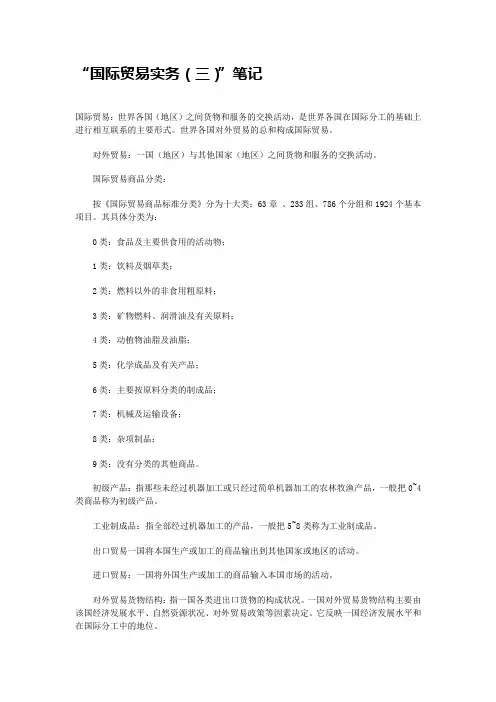
“国际贸易实务(三)”笔记国际贸易:世界各国(地区)之间货物和服务的交换活动,是世界各国在国际分工的基础上进行相互联系的主要形式。
世界各国对外贸易的总和构成国际贸易。
对外贸易:一国(地区)与其他国家(地区)之间货物和服务的交换活动。
国际贸易商品分类:按《国际贸易商品标准分类》分为十大类:63章、233组、786个分组和1924个基本项目。
其具体分类为:0类:食品及主要供食用的活动物;1类:饮料及烟草类;2类:燃料以外的非食用粗原料;3类:矿物燃料、润滑油及有关原料;4类:动植物油脂及油脂;5类:化学成品及有关产品;6类:主要按原料分类的制成品;7类:机械及运输设备;8类:杂项制品;9类:没有分类的其他商品。
初级产品:指那些未经过机器加工或只经过简单机器加工的农林牧渔产品,一般把0~4类商品称为初级产品。
工业制成品:指全部经过机器加工的产品,一般把5~8类称为工业制成品。
出口贸易一国将本国生产或加工的商品输出到其他国家或地区的活动。
进口贸易:一国将外国生产或加工的商品输入本国市场的活动。
对外贸易货物结构:指一国各类进出口货物的构成状况。
一国对外贸易货物结构主要由该国经济发展水平、自然资源状况、对外贸易政策等因素决定。
它反映一国经济发展水平和在国际分工中的地位。
国际服务贸易的定义:乌拉圭回合达成的《服务贸易总协定》(generalAgreementonTradeinServes,简称GATS)将服务贸易界定为四类:1、跨境提供(cross-bordersupply),从一成员境内向任何其他成员境内提供服务(服务的提供者与消费者都不移动);2、境外消费(consumptionabroad),在一成员境内向任何其他成员的服务消费者提供服务(服务消费者过境移动);3、商业存在(commercialpresent),一成员的服务提供者在任何其他成员境内通过商业存在提供服务(服务的提供者将自己的生产要素移动到一缔约国内,通过设立机构并提供服务,取得收入);4、自然人流动(movementofpersonnel),一成员的服务提供者在任何其他成员境内通过自然人提供服务(服务提供者的过境移动在其他缔约方境内提供服务而形成的贸易)。
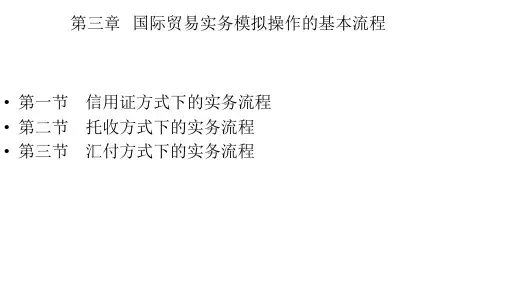

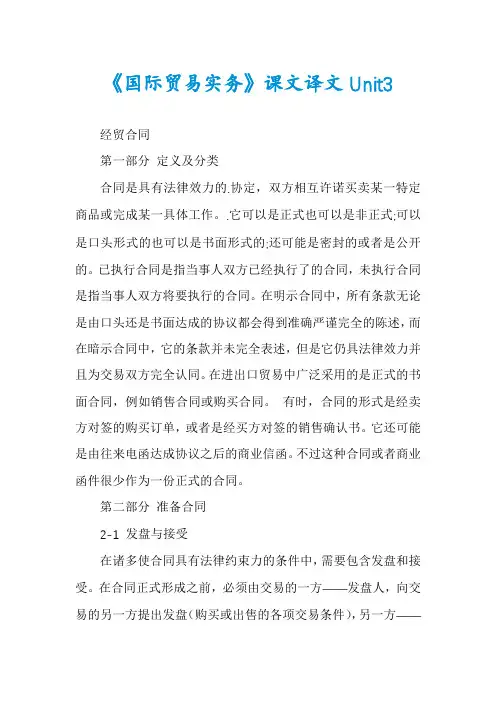
《国际贸易实务》课文译文Unit3经贸合同第一部分定义及分类合同是具有法律效力的.协定,双方相互许诺买卖某一特定商品或完成某一具体工作。
.它可以是正式也可以是非正式;可以是口头形式的也可以是书面形式的;还可能是密封的或者是公开的。
已执行合同是指当事人双方已经执行了的合同,未执行合同是指当事人双方将要执行的合同。
在明示合同中,所有条款无论是由口头还是书面达成的协议都会得到准确严谨完全的陈述,而在暗示合同中,它的条款并未完全表述,但是它仍具法律效力并且为交易双方完全认同。
在进出口贸易中广泛采用的是正式的书面合同,例如销售合同或购买合同。
有时,合同的形式是经卖方对签的购买订单,或者是经买方对签的销售确认书。
它还可能是由往来电函达成协议之后的商业信函。
不过这种合同或者商业函件很少作为一份正式的合同。
第二部分准备合同2-1 发盘与接受在诸多使合同具有法律约束力的条件中,需要包含发盘和接受。
在合同正式形成之前,必须由交易的一方――发盘人,向交易的另一方提出发盘(购买或出售的各项交易条件),另一方――受盘人,接到发盘后决定是否同意其提出条件。
发盘的条款要明确完整而且必须由发盘人或其代理方向其特定的受盘人提出。
受盘人需在合理时间内向发盘人表示接受,否则发盘无效。
发盘可采用口头方式,亦可采用书面方式,它也可以是为双方理解的暗示方式。
发盘可针对一个受盘人发出的,也可以是一个以上的一群人。
除非“发盘被撤销,被受盘人拒绝或被接受,或超过有效期”等情况外,发盘均被视为有效。
发盘有规定的有效期。
撤销发盘象发盘一样也需要通知受盘人。
接受是指受盘人愿意接受对方提出的条件,同意与对方达成交易并及时以书面的声明或承诺送达发盘人。
受盘人接受时如对发盘的内容有任何改动,都可使原发盘失去效力。
他对发盘的回复就变为还盘,原发盘对于其后的接受也不再具有法律效力。
2-2详式合同与简式合同详式合同是正式的书面合同,有关细节一应俱全:(1)品名规格包装麦头(2)数量(3)单价(4)总价(5)装运期限(6)装运口岸(7)目的口岸(8)保险(9)付款条件(10)商品检验(11)不可抗力:由于人力不可抗拒事故,使卖方不能在合同规定期限内交货或者不能交货,卖方不负担责任,但卖方应立即以电报通知买方,如果买方提出要求,卖方应以挂号信函向买方提供证明上述事故存在的证件。

